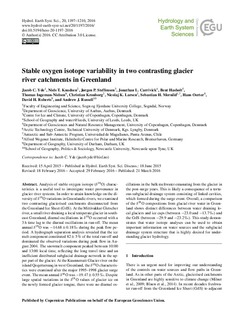| dc.contributor.author | Yde, Jacob Clement | |
| dc.contributor.author | Knudsen, Niels Tvis | |
| dc.contributor.author | Steffensen, Jørgen Peder | |
| dc.contributor.author | Carrivick, Jonathan L. | |
| dc.contributor.author | Hasholt, Bent | |
| dc.contributor.author | Ingeman-Nielsen, Thomas | |
| dc.contributor.author | Kronborg, Christian | |
| dc.contributor.author | Larsen, Nicolaj Krog | |
| dc.contributor.author | Mernild, Jacob Sebastian Haugaard | |
| dc.contributor.author | Oerter, Hans | |
| dc.contributor.author | Roberts, David H. | |
| dc.contributor.author | Russell, Andy | |
| dc.date.accessioned | 2017-07-20T09:00:23Z | |
| dc.date.available | 2017-07-20T09:00:23Z | |
| dc.date.created | 2016-11-03T14:41:18Z | |
| dc.date.issued | 2016 | |
| dc.identifier.citation | Hydrology and Earth System Sciences. 2016, 20 (3), 1197-1210. | nb_NO |
| dc.identifier.issn | 1027-5606 | |
| dc.identifier.uri | http://hdl.handle.net/11250/2449128 | |
| dc.description.abstract | Analysis of stable oxygen isotope (δ 18O) characteristics is a useful tool to investigate water provenance in glacier river systems. In order to attain knowledge on the diversity of δ 18O variations in Greenlandic rivers, we examined two contrasting glacierised catchments disconnected from the Greenland Ice Sheet (GrIS). At the Mittivakkat Gletscher river, a small river draining a local temperate glacier in southeast Greenland, diurnal oscillations in δ 18O occurred with a 3 h time lag to the diurnal oscillations in run-off. The mean annual δ 18O was −14.68 ± 0.18 ‰ during the peak flow period.
A hydrograph separation analysis revealed that the ice melt component constituted 82 ± 5 % of the total run-off and dominated the observed variations during peak flow in August 2004. The snowmelt component peaked between 10:00 and 13:00 local time, reflecting the long travel time and an inefficient distributed subglacial drainage network in the upper part of the glacier. At the Kuannersuit Glacier river on the island Qeqertarsuaq in west Greenland, the δ 18O characteristics were examined after the major 1995–1998 glacier surge event. The mean annual δ 18O was −19.47 ± 0.55 ‰. Despite large spatial variations in the δ 18O values of glacier ice on the newly formed glacier tongue, there were no diurnal oscillations in the bulk meltwater emanating from the glacier in the post-surge years. This is likely a consequence of a tortuous subglacial drainage system consisting of linked cavities, which formed during the surge event. Overall, a comparison of the δ 18O compositions from glacial river water in Greenland shows distinct differences between water draining local glaciers and ice caps (between −23.0 and −13.7 ‰) and the GrIS (between −29.9 and −23.2 ‰). This study demonstrates that water isotope analyses can be used to obtain important information on water sources and the subglacial drainage system structure that is highly desired for understanding glacier hydrology. | nb_NO |
| dc.language.iso | eng | nb_NO |
| dc.rights | Navngivelse 4.0 Internasjonal | * |
| dc.rights.uri | http://creativecommons.org/licenses/by/4.0/deed.no | * |
| dc.title | Stable oxygen isotope variability in two contrasting glacier river catchments in Greenland | nb_NO |
| dc.type | Journal article | nb_NO |
| dc.type | Peer reviewed | nb_NO |
| dc.description.version | publishedVersion | nb_NO |
| dc.source.pagenumber | 1197-1210 | nb_NO |
| dc.source.volume | 20 | nb_NO |
| dc.source.journal | Hydrology and Earth System Sciences | nb_NO |
| dc.source.issue | 3 | nb_NO |
| dc.identifier.doi | 10.5194/hess-20-1197-2016 | |
| dc.identifier.cristin | 1397053 | |
| cristin.unitcode | 216,80,0,0 | |
| cristin.unitname | Avdeling for ingeniør- og naturfag | |
| cristin.ispublished | true | |
| cristin.fulltext | original | |
| cristin.qualitycode | 2 | |

